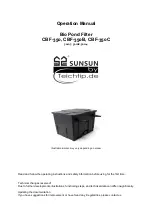
21
Fig. 11: Horizontal Through-the-Wall Direct Venting
Table F: Horizontal Venting Size
Model
No.
Vent Size
(in.)
Maximum Horizontal
Vent Length (ft)*
409B
6”
80
259B
409B
5”
40
259B
80
259B
4”
40
* Subtract 10 ft. per elbow, maximum 4 elbows
The vent must be installed to prevent flue gas leakage.
Care must be taken during assembly to ensure that all
joints are sealed properly and are airtight. The vent
must be installed to prevent the potential accumulation
of condensate in the vent pipes. It is recommended
that the vent be insulated. Insulation is required for
installations in cold environments (i.e. below 40°F or
4°C). It is required that:
1. The vent must be installed with a condensate
drain located in proximity to the heater as directed
by the vent manufacturer.
2. The vent must be installed with a slight upward
slope of not less than 1/4 inch per foot of horizon-
tal run to the vent terminal.
Termination
The direct vent cap MUST be mounted on the exterior
of the building. The direct vent cap cannot be installed
in a well or below grade. The direct vent cap must be
installed at least 1 ft above ground level and above
normal snow levels. The Raypak-approved stainless
steel direct vent cap must be used. The vent terminal
must be located NO CLOSER than 12” off the wall.
WARNING:
No substitutions of flue pipe or vent
cap material are allowed. Such substitutions would
jeopardize the safety and health of inhabitants.
Direct Vent - Horizontal Through-
the-Wall
Installation
These installations utilize the heater’s internal blower
to draw combustion air from outdoors and vent com-
bustion products to the outdoors.
The total length of the through-the-wall flue cannot
exceed 80 equivalent ft in length for the flue outlet.
Each elbow used is equal to 10 ft of straight pipe. This
will allow installation in one of the five following
arrangements:
• 80’ of straight flue pipe
• 70’ of straight flue pipe and one elbow
•
60’ of straight flue pipe and two elbows
•
50’ of straight pipe and three elbows
•
40’ of straight pipe and four elbows
The flue direct vent cap is not considered in the overall
length of the venting system.
Care must be taken during assembly that all joints are
sealed properly and are airtight.
The vent must be installed to prevent the potential ac-
cumulation of condensate in the vent pipes. It is rec-
ommended that the vent be insulated. Insulation is
required for installations in cold environments (i.e.
below 40°F or 4°C).
For installations in extremely cold climate, it is re-
quired that:
1. The vent must be installed with a slight upward
slope of not more than 1/4 inch per foot of hori-
zontal run to the vent terminal. An approved con-
densate trap must be installed per applicable
codes.
2. The intake vent must be insulated through the
length of the horizontal run.
















































